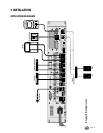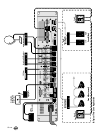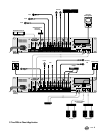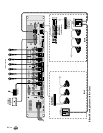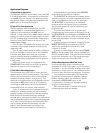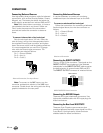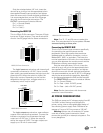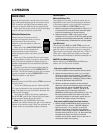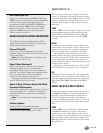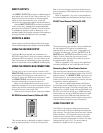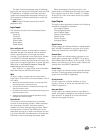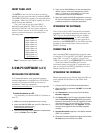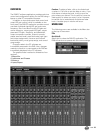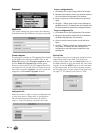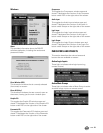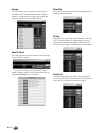
DX8 – 15
Bus A and B Input Trim
There is no metering after the BUS A and B input
TRIM controls. These controls must be adjusted by
ear. Start the program source playback for all
sources connected to the BUS A or BUS B input.
Slowly increase the TRIM control to the center
position (12 o'clock), which is unity gain. Then
adjust the TRIM control up or down to attain a
balance within the total mix.
USING THE DIGITAL SIGNAL PROCESSORS
The DX8 has five powerful floating-point 32-bit
digital signal processors (DSPs) to implement the
digital audio processing functions.
Channel 3-Band EQ
Each of the inputs is equipped with a 3-band
equalizer. Use this to adjust the overall tonal quality
of the input signal.
Note: The channel EQ gain and frequency are
adjustable from the PC only.
Output 2-Band Shelving EQ
Each of the outputs is equipped with a 2-band
shelving equalizer. Use this to make broad
equalization adjustments to the output signals of
the DX8. The output EQ gain can be adjusted from
the front panel, and the EQ gain and corner
frequency can be adjusted from the PC.
The center gain position (0 dB) is indicated when
both "0" LEDs are lit on the meter.
Output 31-Band 1/3 Octave Graphic EQ/5-Band
Parametric EQ/Compressor
Each of the outputs is also equipped with a 31-band
1/3 octave graphic EQ. In addition, a 5-band true
parametric EQ and a compressor are available on
each output.
Note: These functions are adjustable from the
PC only.
Software Updates
Check the EAW Commercial website at
www.eawcommercial.com for new information and
updates to the DX8 software and firmware.
USING INPUTS 1-8
Connect the microphones or program sources to
Inputs 1-8. Examples of program sources include a
CD player, tape deck, tuner, satellite feed, TV audio,
jukebox, or other audio source. Each input has a
separate Phoenix-type connector for a mic or line-
level input.
TRIM
Use the TRIM control to adjust the gain of the input
preamp stage according to the level of the input
signal. Refer to the "Quick-Start" section (Set the
Levels) for instructions on how to set the TRIM
controls.
LEVEL
The up/down arrow buttons on each channel are
used to adjust the mix level for each channel. Use
these to fine tune the mix or relative loudness of
each input signal that is connected to the DX8.
When adjusting these buttons, the channel
meter indicates the gain of the channel relative to
the maximum gain of +10 dB. After 5 seconds, the
meter reverts back to indicating the actual input
signal level of the channel. This metering is pre-EQ
and pre-LEVEL control.
Unity gain is indicated when the –10 and –7 dB
LEDs are both lit on the meter (or "U" on-screen).
EQ
Each Input 1-8 has a 3-band EQ. This is adjustable
from the PC only. It provides 15 dB of boost or cut
with user selectable corner and center frequencies
(LO: 20Hz-500Hz; MID: 20Hz-20kHz; HI: 500Hz-
20kHz).
USING THE BUS A AND B INPUTS
These inputs provide a direct analog connection to
the BUS A and B buses. These input points are
post-DSP and post-D/A converter, and accept a
balanced analog line-level signal. Use these to
connect an additional program source to a zone, or
to connect the Zone A and B outputs from another
DX8.
TRIM
Use the TRIM control to adjust the signal level at
the BUS A and B inputs. Typically, this control
would be set to the center detent position (unity
gain). However, it can be adjusted up or down by 20
dB to achieve a balance between the signal at the
BUS A and B inputs, and the signal on the internal
A and B buses.



